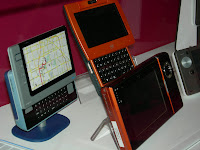On the eve of
CES 2008, it seems appropriate to look back on developments in Ultra Mobile
PC's in 2007. First we had the
UMPC category. Then it was renamed as "
UMD" (Ultra Mobile Device, not to be confused with
WMD's, Weapons of Mass Destruction). Finally, it was renamed as "MID" or Mobile Internet Device. Other than a lot of three letter acronyms, what does this really signify?
To start, this indicates that the
UMPC/
UMD/MID category is a segment in search of a market niche. The features, functionality, and implementation of the first several generations of
UMPC's have been less than
overwhelming to consumers, so the marketers are hard at work trying to redefine the segment, the market or both.
In it's latest incarnation, the 'MID" has transitioned from the Windows-based
UMPC used as
miniature PC to a Linux-based device which is either fixed function or built as a dedicated device for a particular usage.
The Good: Although the iPhone and its sibling the
iPod Touch were not classified as
MID's by Apple, it has the key features which were originally targeted by the
UMPC/
UMD/MID segment, namely anywhere
Internet access using both
WWAN (EDGE for the iPhone) and
WiFi (for both the iPhone and
iPod Touch). These devices render full fidelity web pages using the Safari browser and the embedded OS X. While one can argue that Flash
plugin for animation is not supported, this is more of a strategic choice by Apple to promote
Quicktime rather than a technical limitation of the iPhone/
iPod Touch. Further, Apple has even opened up the devices to third party developers after initially closing off the devices to these developers.
Another product which deserves mention is the
Nokia N800 and the newly introduced N810. The N800, shown at
CES 2007 and shipping in volume in January, showed how a small, light device running Linux, priced at $399 could do most of functions of the
UMPC while being half the size and weight of any shipping self identified "
UMPC". The N810 added a keyboard to the outstanding N800, and increased the price to $480.
The Bad: The majority of the
UMPC's introduced in 2007 fall into this category. All were too large to be
pocketable, too heavy, too limited in battery life to
fulfil the
UMPC promise. The poster child of bad
UMPC's is the
Samsung Q1 Ultra. The second generation of Q1 was introduced last year with a split keyboard that seem to kludged on the case.
The Ugly: The
Oqo Model 2 is a beautifully looking device to be sure. But its price, from $1,500 (since lowered to $1,300) to over $2,000 is "ugly" and unfriendly to consumers. The Model 2 changed out the underpowered, and overly hot
Transmeta processor for a Via processor and added
WWAN radio. The
Oqo is still the smallest and best designed of the crop of
UMPC's but it's pricing indicates its target segment is business vertical markets, not consumers.
So, I'm looking forward to some new announcements at
CES next week that shows there is still life left in this segment.
 This new low happened less than a week after Intel announced an almost $8B acquisition of security software company McAfee. I was thinking about this today as I was driving down the 101 freeway in Santa Clara and passed by McAfee and Intel's headquarters.
This new low happened less than a week after Intel announced an almost $8B acquisition of security software company McAfee. I was thinking about this today as I was driving down the 101 freeway in Santa Clara and passed by McAfee and Intel's headquarters.













